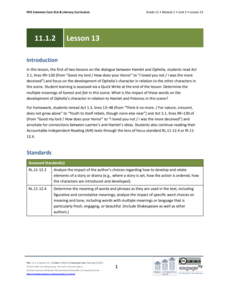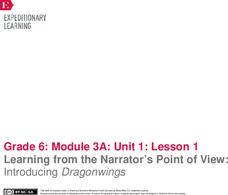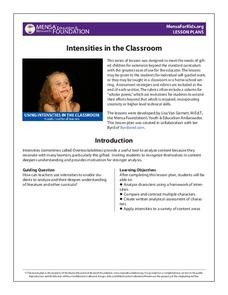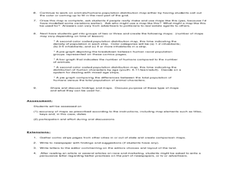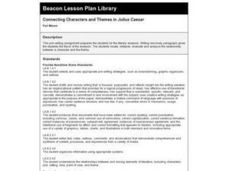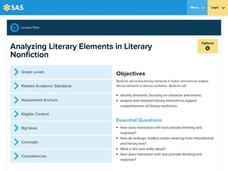Penguin Books
A Guide to the Works of Jacqueline Woodson
The works of Jacqueline Woodson introduce readers to diverse characters and themes. A guide covers many of the author's best-known books such as Brown Girl Dreaming and Locomotion. Dive & Discuss and Explore & Extend activities...
College Board
2007 AP® English Literature and Composition Free-Response Questions
Scholars use the 2007 AP® English Literature and Composition Free-Response Questions to write essays examining how a character's tie to the past affects the story. The resource also requires pupils to write essays comparing two related...
EngageNY
Grade 11 ELA Module 1: Unit 2, Lesson 13
What impact does word choice have on character development? Using the resource, scholars read Act 3.1 from Shakespeare's Hamlet, focusing on the development of Ophelia's character. They also complete a Quick Write to analyze the meaning...
EngageNY
Author’s Craft: The Poetry of the Play
Feel the rhythm! Pupils begin reading Act 2, Scene 1 of Shakespeare's A Midsummer Night's Dream as they continue participating in a drama circle. With discussion, they examine Shakespeare's use of rhyme, rhythm, and meter, analyzing how...
EngageNY
Learning from the Narrator’s Point of View: Introducing Dragonwings
Journey into the past with Laurence Yep's Dragonwings. Scholars complete anchor charts to analyze techniques the author uses to develop the narrator's point of view in his novel. As they read, pupils also complete word catchers to track...
J. Paul Getty Trust
Expressing Emotions through Art Lesson 1—Everyone Shows They Care
In a instructional activity that explores art and emotions, scholars analyze a piece of art and discuss which emotions it portrays. They go on to reflect on their own emotions and how they are similar to the feelings expressed...
EngageNY
Grade 11 ELA Module 1: Unit 2, Lesson 6
How does Shakespeare develop the characters of Laertes and Ophelia in Hamlet? Scholars complete a Quick Write to answer the question. They also continue reading and discussing the first act of the play.
Curated OER
Language Arts: Character Comparison
Fourth graders, using Kidspiration, compare and contrast the two main characters from Tales of a Fourth Grade Nothing. They use a teacher-created template to describe their characters. Students then create their own character analysis.
Curated OER
"Et tu, Brute?" - The Characters, Conflict and Historical context of Shakespeare's Julius Caesar
Students analyze the Shakespearian play, "Julius Caesar" in this seven lesson unit. Through readings, hands-on projects, and the study of plot development, comparisons are made to the movie and the historical records available.
Curated OER
Character Cluster
Third graders practice identifying characters and story elements by creating a character cluster in class. In this story analysis instructional activity, 3rd graders discuss the story Snow White and identify the characteristics of the...
MENSA Education & Research Foundation
Intensities in the Classroom
Everyone learns and experiences life differently. A set of lessons about character intensities encourages middle and high schoolers to analyze themselves, their peers, and characters from a book based on the five listed intensities:...
Novelinks
The House on Mango Street: List-Group-Label
Encourage close reading of the text and a focus on how Sandra Cisneros' develops her characters with an activity that asks teams to sort, group, and label character descriptions from The House on Mango Street.
Curated OER
Comparing Characters Across Two Short Stories
Ninth graders listen to a read aloud of two short stories focusing on literary devices. The write about the settings and realism of the stories, and decide each main character handles the conflict he faces with nature.
Curated OER
What is the Population Distribution of Cartoon Characters Living On the Pages of Your Newspaper?
Students read various cartoons in their local newspaper and calculate the population demographics, spatial distribution and grouping of the characters. Using this information, they create a population distribution map and share them with...
Curated OER
Connecting Characters and Themes in Julius Caesar
Fourth graders prepare for the literary analysis. They locate, interpret, evaluate and analyze the relationship between a character and the theme. After a lecture/demo, 4th graders write topic and detail sentences, then correctly put...
Curated OER
Analyzing Story Structure
Students explore language arts by completing a graphic organizer in class. In this story structure lesson, students read the poem "Sick" by Shel Silverstein and discuss the different elements in the piece which make it an effective poem....
Pennsylvania Department of Education
Analyzing Literary Elements in Literary Nonfiction
Fourth graders identify the literary elements of a nonfiction text. In this literary elements lesson, 4th graders read the text Piano Starts Here--The Young Art Tatum and fill in a chart that includes the events from the book....
Curated OER
Mr. Peabody's Apples
Students read Mr. Peabody's Apples. In this reading instructional activity, students complete pre-and post-reading activities to improve comprehension skills. Students role play scenes from the story to analyze.
Curated OER
Touchstone Vs. Jaques: a Analyzing Mood in As You Like It
Pupils recognize ways Shakespeare creates and uses mood augment their analysis of the text and help them in making performance choices. They, in groups, select words, phrases, lines, that reveal their character's mood.
Virginia English Bulletin
Book Trailer Projects From Classroom to Community
Invite your pupils to express their understanding of a novel through a collaborative video project. Groups choose a novel from those you have studied in class, select four scenes, storyboard the scenes, film the scenes, edit the film,...
Literacy Design Collaborative
"New American Characters" - Analyzing the Impact of Cultural Change in "The Great Gatsby"
Learners annotate text from The Great Gatsby before working through a character development map. They then use text evidence in a final essay to describe the connection between central ideas and character development.
Curated OER
Cashing In on Cartoons
Students examine the popularity of cartoon characters in marketing strategies. They work on developing their own cartoon characters that could be used for a licensing plan.
Curated OER
Seedfolks
Students explore sequencing. In this sequencing lesson, students sequence events to analyze character actions as cause and effect or the plot of the story. Students discuss character actions and list them on a chart.
Curated OER
Reading Comprehension
For this reading comprehension lesson, 3rd graders read the story Treasury of Literature and complete various comprehension activities. Students answer factual questions about the story, analyze the story using a bubble map, and extend...
Other popular searches
- Analyzing Characters Mystery
- Analyzing Characters Notes
- Analyzing Characters Buck
- Analyzing Characters Paper




